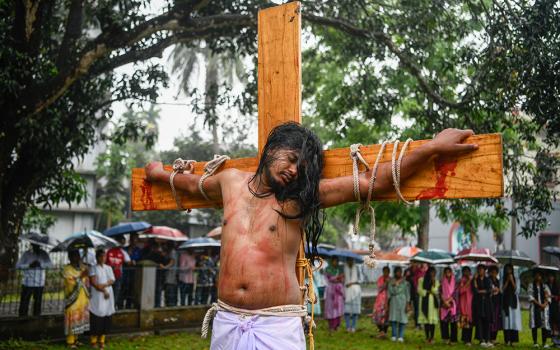
Samphran, Thailand
Analysis
Asian Catholic women religious leaders find themselves entering an uncertain limbo, caught between their church's gospel teachings and lofty pro-women rhetoric, on the one hand; and limiting, social, cultural and ecclesial realities, on the other.
It seems this is a place where countless educated Catholic women throughout the world find themselves, but it is a special reality in Asia where centuries of patriarchal religious customs resistant to change clash with Catholic women who are increasingly being exposed to contemporary spirituality and feminist theological thought.
The tensions between Christian ideals and Catholic realities, between gospel imperatives and more traditional women's roles in Asian societies, were on display during nine days of talks and reflections at AMOR XV, a gathering here of 115 women religious leaders from throughout Asia and Oceania.
When the women concluded their meeting with great enthusiasm and hope they issued a statement pledging radical shifts in the way they carry out their missions, and another offering prayerful solidarity with U.S. women religious facing two Vatican investigations.
AMOR stands for Meeting of Asia and Oceania Religious and the women gather every few years to listen, share stories and encourage each other. In the process, many of their common frustrations come to light as they talk about ways in which church structures limit their contributions as active agents of the gospel.
Echoing a passage in Mark's gospel (7:24-29) in which a Syro-Phoenician Woman challenged Jesus, the women pledged to "move beyond" and renew their internal spiritual centers as they gather strength to challenge external structures and habits.
The gathering was held Oct. 13-21 and the theme, "Called to Move Beyond," was the primary motif of the meeting and the women took it seriously throughout their discussions, which included many spiritual reflections.
Notably, AMOR XV was held in Thailand, a nation characterized by ancient patriarchal religious structures but a nation in which women have made great social strides in recent decades. Thailand mirrors much of the rest of Asia, where conservative traditions have come into conflict with outside forces, some for the good, and others for the bad.
Throughout this change, women in Asia have had greater access to education and with it have come more demands for gender equity. Moves in the direction of equity have gained foothold in politics, social and financial structures. A notable exception has been within the ranks of the Catholic church.
Several years ago, for example, Korean women, after having had virtually no role in the nation's political life, pushed hard and won a 30 percent quota in the Seoul parliament. Following suit, Catholic women pushed for a 30 -- then a 20 -- percent quota on church committees, including parish councils. The Korean bishops, however, have ignored these requests.
Indian Catholic women have also pressed hard for more open dialogue with the church hierarchy on women's roles within the church. These requests have also largely been ignored.
When the Federation of Asian Bishops Conference met in Manila last August reportedly of the 60 people who addressed the assembly only one was a woman.
Educated Asian women religious, pious by nature and characteristically reluctant to challenge authority, nevertheless, feel pinched between the liberating mandates of the gospel, as they have begun to see them, and the more restrictive habits of local bishops.
The pot has been simmering for four decades now.
It was in 1970, in the wake of Vatican II that the Asian bishops formed the Federation of Asian Bishops Conferences, (FABC) a pan-Asian umbrella organization aimed at increasing dialogue. This dialogue eventually was to include women.
When the FABC met in a plenary session Tokyo in 1986 enough women's voices had been heard to pressure the bishops is address the issue. They wrote that it is "not just a human necessity but a gospel imperative that women are recognized and their dignity restored, and that they are allowed to play their rightful role in the world and in the church."
The FABC, meeting in Malaysia in 1993, recommended setting up a women's commission and encouraged the national bishops' conferences to do the same, with one of the objectives to promote "encounters and dialogue between women and men in the church, especially in decision-making."
The FABC, meeting in Manila in 1995, said it was "an urgent pastoral imperative" for women "to exercise their right to co-responsibility and mutuality with men -- in society and in the church."
The Asian bishops called for women's commission to be set up within the office of the laity and in the years that followed women and bishops came together, but out of this little changed.
For its part, AMOR was part of the spiritual awakening and justice response that followed Vatican II and the 1971 synod on justice at which the bishops of the church stated that "action on behalf of justice is constitutive of the gospel." Asian women recognized that a call for justice could not exclude the church itself. There have now been 15 AMOR gatherings.
It was, meanwhile, in November 2002 that the Asian women took discourse and organizing to a new level. Fifty-five Asian women theologians that month gathered in Bangkok to create an organization called "Ecclesia of Woman in Asia" (EWA). The idea for the organization was given birth a year earlier in India at an Asian theological conference held to reflect on the document, "Ecclesia in Asia," issued in 1999 by Pope John Paul II, following the 1998 Asian synod held in Rome.
Reflecting the growing frustration of Asian women theologians, the title of the five-day 2002 gathering was "Ecclesia of Women in Asia: Gathering the Voices of the Silenced." Their aim was to build a more inclusive church.
That first EWA conference drew 60 women from 18 Asian nations: China, Hong Kong, Taiwan, Korea, Japan, Vietnam, Philippines, Malaysia, Singapore, Indonesia, East Timor, Thailand, Myanmar, Pakistan, Bangladesh, India, Sri Lanka and Australia.
Neither AMOR nor EWA have canonical status. Both have provided platforms for Asian women
Asian women religious, meanwhile, have quietly found ways to take their missions increasingly into their own hands, breaking out of models of religious congregations that have worked to keep clerical institutions running.
An example of this self-determination is evident in the opening earlier this year by Indian women religious of a new theology research institute whose purpose is to empower women religious.
The ideas for the center came out of a meeting last year of some 350 women religious superiors, representing more than 90,000 women religious. Its stated aim is to carry out research on gender issues and women's studies, with special emphasis on theological and religious perspectives. The Indian women religious say they recognize education and particularly theological education, is key to advancing women in the church.
Asian women religious, as the AMOR XV assembly showed, increasingly are finding the need to become active agents of their own journeys. No congregation has mentioned bolting from the ranks, but many are increasingly vocal about perceived injustices outside -- and inside the church – and together they are working to respond to a call to "move beyond."
Tom Fox is NCR editor and can be reached at tfox@ncronline.org.


